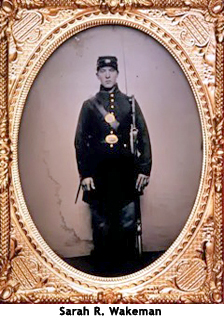|
Sarah Rosetta Wakeman: an uncommon
female soldier whose gender undiscovered
By DR. JUDY PIERCE
Bugle Staff Writer
 Researchers indicate that anywhere from 400 to 1,000 women became soldiers disguised as men during the Civil War. Many of the women who joined the army were virtually unknown due to lack of documentation. But, Sarah Rosetta Wakeman’s army career as Pvt. Lyons Wakeman is well documented. Researchers indicate that anywhere from 400 to 1,000 women became soldiers disguised as men during the Civil War. Many of the women who joined the army were virtually unknown due to lack of documentation. But, Sarah Rosetta Wakeman’s army career as Pvt. Lyons Wakeman is well documented.
The documentation is not only found in official records of the Civil War, but in the many letters she wrote home describing her life with the 153rd New York Infantry Volunteers.
Sarah was born Jan. 16, 1843, on a farm near Afton, N.Y., the eldest of nine children. The family was very poor and, despite the hard work they did, the farm could barely support a large family.
Upon Sarah’s 17th birthday, she was able to find work as a domestic servant in order to make extra money to help her family. During the two years she worked as a servant, Sarah learned that in order to make higher wages, it would be better to dress as a man and leave home. During the middle of the night, Sarah packed what little clothing she had, left a note explaining why she left, and headed for bigger and better things.
In 1862, Sarah changed her name to Lyons Wakeman, cut her long hair short as possible, and disguised herself as a man. Binghamton, N.Y. was her first stop. Sarah took a job for two weeks for $4 and later heard about a job on a river barge that paid much more. She signed on with a barge for four trips to carry coal up the Chenango Canal from Binghamton to Utica, N. Y. However, the river barge did not stop in Utica, but went eastward down the Mohawk River to Canajoharie, N.Y. Sarah was quite upset when she learned that she would not receive any additional pay for the trip.
One day while walking down the street of Canajoharie, Sarah met several soldiers from the 153rd New York State Volunteers. They advised her that the new regiment was being formed at Fonda, New York. The soldiers said that joining the regiment meant good steady pay and a sign-on bonus of $152.
On Aug. 30, 1862, Sarah, using the name of Lyons Wakeman, enlisted in Company G of the newly formed regiment. Her enlistment was for three years or the duration of the war. Pvt. Lyons Wakeman was five feet tall, with a light complexion, blue eyes and brown hair.
The 153rd regiment was mustered into the United States Service on Oct. 17, 1862, at Fonda, N. Y. The regiment was ordered to leave for Washington the next day.
The regiment arrived in Washington City on Oct. 22, 1862 and was assigned provost martial and guard duty in Alexandria, Va. The regiment was part of the defenses of Washington. Nine months later, the regiment was transferred from Alexandria to Washington and quartered at Capitol Hill. The regimental duties were to patrol the city, guard the B & O Railroad depot, escort prisoners of war to the prison at Point Lookout, Md., and guard the ex-slave refugee camp among other things.
On Feb. 17, 1864, the 153rd regiment was transferred to field duty under the command of Major Gen. Nathaniel P. Banks, to fight in the Red River Campaign in Louisiana. The Union was trying to capture Shreveport, La., to open a route for a federal assault on Texas.
The Red River Campaign was the first battle for Pvt. Wakeman. Since the regiment had continually trained for battle while stationed in Washington, the soldiers were ready. Morale was high among the members of the regiment. The regiment left aboard the steamship Mississippi on Feb. 20 for Agiers, La. Next, they boarded a train to Brasher City where they met other regiments and marched 53 miles to Franklin. They planned to march from Franklin through Alexandria and Natchitochis directly into Shreveport.
Although it was a good plan, the regiment did not reach Shreveport because Confederate soldiers were waiting for them at Sabine Crossroads, about 40 miles south of Shreveport. The 153rd New York Volunteers were ordered to stay away from the battle to guard the wagons and supplies. Regrettably, the battle was a defeat for the Union soldiers and they withdrew about 20 miles south to Pleasant Hill. On April 9, 1864, the 153rd New York Volunteers fought in their first battle.
Sarah described the horrible battle in a letter to her family. The regiment repelled six charges by the Confederate troops under Major Gen. Dick Taylor. Sarah wrote that the regiment “layed all night on the battle field among the wounded and dead.” The 153rd Regiment was successful and now had a taste of the cruel realities of the war.
The battle at Pleasant Hill was a victory for Gen. Banks. Some of the Union weapons and supplies seized by Confederate soldiers at Sabine Crossroads were recovered during the battle.
The Union army returned to Grand Encore to rest and re-evaluate its position. While Pvt. Wakeman’s regiment was camped at Grand Encore with the rest of Gen. Banks’ forces, a scout advised him that Gen. Taylor’s forces had circled around their rear farther down the river.
Banks ordered the troops to immediately strike camp. Late that evening, the forces set out on a 70-mile march to Alexandria. They marched from 10 o’clock the evening of April 21 until midnight on April 22 and only covered about 35 miles. The Union forces reached Monett’s Bluff and the Cane River Crossing on the morning of April 23. The Confederate troops were strongly entrenched on the opposite bank of the river.
Pvt. Wakeman’s brigade was ordered to lie down in the woods on the Union side of the river and wait for General Banks’ Third Brigade to cross the water three miles north and attack the Confederate soldiers on their left flank. They lay in wait in the woods all day listening to constant bombardment from the Confederate cannon. At 4 o’clock in the afternoon, Wakeman’s brigade was ordered to cross the river and make a frontal attack. The attack was successful and this allowed the army to finally reach Alexandria.
On May 3, Pvt. Wakeman complained of chronic diarrhea and reported to the regimental hospital. A few days later she was transferred to the Marine USA General Hospital in New Orleans. During the trip, the river was under siege by the Confederate troops. When Pvt. Wakeman arrived at the hospital, her condition was listed as critical. After a month in the hospital, Pvt. Wakeman died on June 19, 1864. She was never discovered as being a woman.
Sarah was buried south of New Orleans at the Chalmette National Cemetery as Lyons Wakeman. Her grave is marked with number 4066. The 153rd New York Volunteers lost about 200 soldiers in battle while one officer and 160 soldiers died of disease. Sarah Rosetta Wakeman was one of them.
|














 Researchers indicate that anywhere from 400 to 1,000 women became soldiers disguised as men during the Civil War. Many of the women who joined the army were virtually unknown due to lack of documentation. But, Sarah Rosetta Wakeman’s army career as Pvt. Lyons Wakeman is well documented.
Researchers indicate that anywhere from 400 to 1,000 women became soldiers disguised as men during the Civil War. Many of the women who joined the army were virtually unknown due to lack of documentation. But, Sarah Rosetta Wakeman’s army career as Pvt. Lyons Wakeman is well documented.